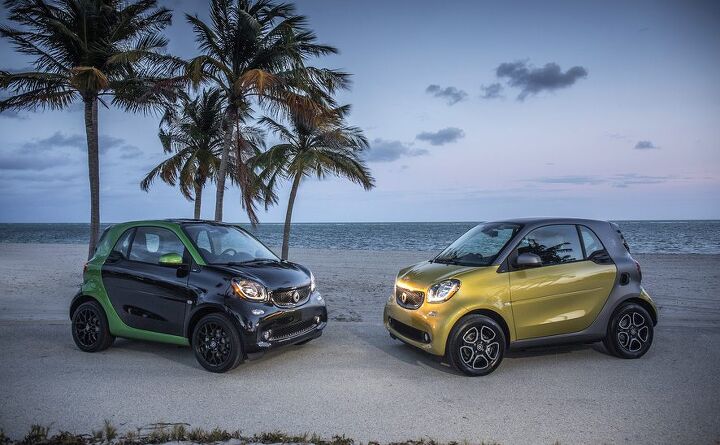Incredibly Small Car Brand Loses Its Head

People make fun of automakers with severely limited vehicle lineups, but Mitsubishi has nothing on the diminutive — in every sense of the word — Smart brand. Note: we’re using a capital “S” here and always will.
Technically, the Daimler AG division sells a single model in the United States, though the powers that be break it up into two: coupe and cabriolet. Well known for being the smallest, lightest mass-produced new car on the domestic market, the Fortwo quickly gained a reputation for having the jerkiest, most unsatisfying transmission in existence. Recently, engine fires sparked (pardon the pun) a recall of 43,000 2008-2009 vehicles in the U.S. and 7,000 in Canada.
Born as a diesel-powered division before changing over to gasoline propulsion, Smart has now evolved into an electric-only brand. And its U.S. sales have never been lower. Maybe the new head of Smart will have some ideas.
Announced Tuesday, CEO Dr. Annette Winkler will step down from the division’s helm after eight years, effective September 30th. Winkler has been with Daimler for 23 years.
“One of the key responsibilities of every executive is to pass on leading positions to the next generation at the right time,” Winkler said in a statement. “And that time has now come – with the clear focus of smart as a fully electric urban-mobility brand and with the decision to develop the Hambach facility into a plant for fully electric vehicles within the Mercedes-Benz production network. With my endless passion for smart and the people behind it, this decision was not easy for me. I am all the more pleased that I can now support the handover to a successor.”
Currently, the identity of Winkler’s replacement remains a mystery, much like the brand’s future.
Dr. Dieter Zetsche, Daimler chairman and Mercedes-Benz boss, said “the smart plant in Hambach has continually improved its competitiveness and is extremely well positioned for the future” thanks to Winkler’s efforts. The company recently announced plans to produce a small, EQ-badged Mercedes-Benz vehicle at Hambach.
Now that Smart is an entirely electric entity, at least in North America, Daimler saw fit to bestow its “EQ” label on the brand and its vehicles. For the 2018.5 model year, the division becomes “Smart EQ,” with its sole U.S. vehicle sold as the Smart EQ Fortwo Electric Drive. The model draws 80 horsepower and 118 lb-ft of torque from its electric motor, making it the fastest Fortwo to date. A price cut accompanied the brand’s green evolution.
Sadly, the electric model’s 2017 update saw range fall from an already paltry 68 miles to an even worse 58 miles, making this “city car” an urban denizen purely out of necessity. In the U.S. in April, just 93 customers picked up a Fortwo Electric Drive. 33 Canadians did the same.
This is quite a fall for the Fortwo, which, in its first year on the U.S. market (2008), sold 24,622 examples. Last year’s tally amounted to 3,071 vehicles, and the first four months of 2018 show a 70.8 percent volume loss. A rare car, indeed. Not unsurprisingly, there’s even a cheaper lease on leftover 2017 models advertised on Smart’s U.S. consumer website.
In the division’s home market, customers get a choice between two- and four-seater models, and cars can still be ordered with internal combustion engines (Smart goes all-electric there in 2020). Given the wide differences between North America and the continent, it’s not a shock to see Smart’s European sales topped 100,000 units in the past two calendar years. This side of the Atlantic, however, it’s a hen’s tooth.
[Images: Daimler AG]

More by Steph Willems
Latest Car Reviews
Read moreLatest Product Reviews
Read moreRecent Comments
- Corey Lewis It's not competitive against others in the class, as my review discussed. https://www.thetruthaboutcars.com/cars/chevrolet/rental-review-the-2023-chevrolet-malibu-last-domestic-midsize-standing-44502760
- Turbo Is Black Magic My wife had one of these back in 06, did a ton of work to it… supercharger, full exhaust, full suspension.. it was a blast to drive even though it was still hilariously slow. Great for drive in nights, open the hatch fold the seats flat and just relax.Also this thing is a great example of how far we have come in crash safety even since just 2005… go look at these old crash tests now and I cringe at what a modern electric tank would do to this thing.
- MaintenanceCosts Whenever the topic of the xB comes up…Me: "The style is fun. The combination of the box shape and the aggressive detailing is very JDM."Wife: "Those are ghetto."Me: "They're smaller than a Corolla outside and have the space of a RAV4 inside."Wife: "Those are ghetto."Me: "They're kind of fun to drive with a stick."Wife: "Those are ghetto."It's one of a few cars (including its fellow box, the Ford Flex) on which we will just never see eye to eye.
- Oberkanone The alternative is a more expensive SUV. Yes, it will be missed.
- Ajla I did like this one.


































Comments
Join the conversation
Where the article gets it wrong is that the new transmissions are great. HUGE night and day improvement over the old ones. Put it into sport mode and shifts are now immediate and has some acceleration. AND.... its fast or feels crazy fast for city driving. Have experience via Car2Go for this, and I prefer it to the other Car2Go offerings (GLA, CLA) because it is so small you can park it in "event parking" like a block away from a stadium hockey game whereby no regular car could ever find a space big enough. and at $0.41 cents a minute (car2go) I am a buyer.
Give it the Old Yeller treatment - take it out in the yard and blast it.